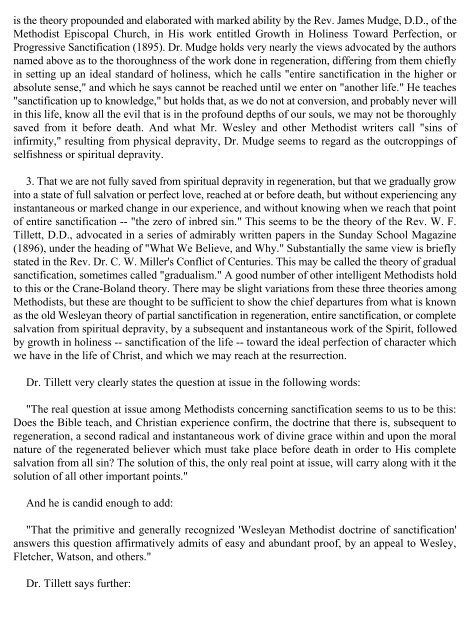Scriptural Sanctification - Media Sabda Org
Scriptural Sanctification - Media Sabda Org
Scriptural Sanctification - Media Sabda Org
You also want an ePaper? Increase the reach of your titles
YUMPU automatically turns print PDFs into web optimized ePapers that Google loves.
is the theory propounded and elaborated with marked ability by the Rev. James Mudge, D.D., of the<br />
Methodist Episcopal Church, in His work entitled Growth in Holiness Toward Perfection, or<br />
Progressive <strong>Sanctification</strong> (1895). Dr. Mudge holds very nearly the views advocated by the authors<br />
named above as to the thoroughness of the work done in regeneration, differing from them chiefly<br />
in setting up an ideal standard of holiness, which he calls "entire sanctification in the higher or<br />
absolute sense," and which he says cannot be reached until we enter on "another life." He teaches<br />
"sanctification up to knowledge," but holds that, as we do not at conversion, and probably never will<br />
in this life, know all the evil that is in the profound depths of our souls, we may not be thoroughly<br />
saved from it before death. And what Mr. Wesley and other Methodist writers call "sins of<br />
infirmity," resulting from physical depravity, Dr. Mudge seems to regard as the outcroppings of<br />
selfishness or spiritual depravity.<br />
3. That we are not fully saved from spiritual depravity in regeneration, but that we gradually grow<br />
into a state of full salvation or perfect love, reached at or before death, but without experiencing any<br />
instantaneous or marked change in our experience, and without knowing when we reach that point<br />
of entire sanctification -- "the zero of inbred sin." This seems to be the theory of the Rev. W. F.<br />
Tillett, D.D., advocated in a series of admirably written papers in the Sunday School Magazine<br />
(1896), under the heading of "What We Believe, and Why." Substantially the same view is briefly<br />
stated in the Rev. Dr. C. W. Miller's Conflict of Centuries. This may be called the theory of gradual<br />
sanctification, sometimes called "gradualism." A good number of other intelligent Methodists hold<br />
to this or the Crane-Boland theory. There may be slight variations from these three theories among<br />
Methodists, but these are thought to be sufficient to show the chief departures from what is known<br />
as the old Wesleyan theory of partial sanctification in regeneration, entire sanctification, or complete<br />
salvation from spiritual depravity, by a subsequent and instantaneous work of the Spirit, followed<br />
by growth in holiness -- sanctification of the life -- toward the ideal perfection of character which<br />
we have in the life of Christ, and which we may reach at the resurrection.<br />
Dr. Tillett very clearly states the question at issue in the following words:<br />
"The real question at issue among Methodists concerning sanctification seems to us to be this:<br />
Does the Bible teach, and Christian experience confirm, the doctrine that there is, subsequent to<br />
regeneration, a second radical and instantaneous work of divine grace within and upon the moral<br />
nature of the regenerated believer which must take place before death in order to His complete<br />
salvation from all sin? The solution of this, the only real point at issue, will carry along with it the<br />
solution of all other important points."<br />
And he is candid enough to add:<br />
"That the primitive and generally recognized 'Wesleyan Methodist doctrine of sanctification'<br />
answers this question affirmatively admits of easy and abundant proof, by an appeal to Wesley,<br />
Fletcher, Watson, and others."<br />
Dr. Tillett says further:
















